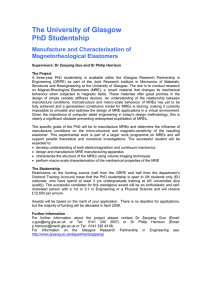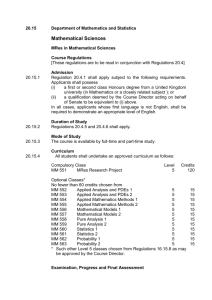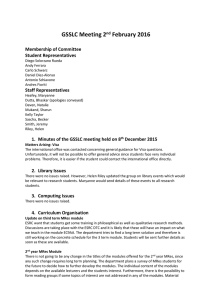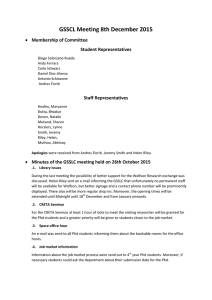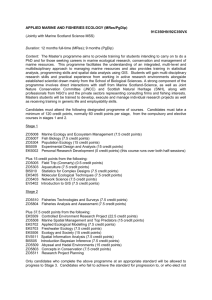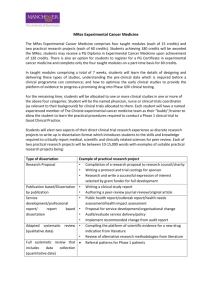Document 13135736
advertisement
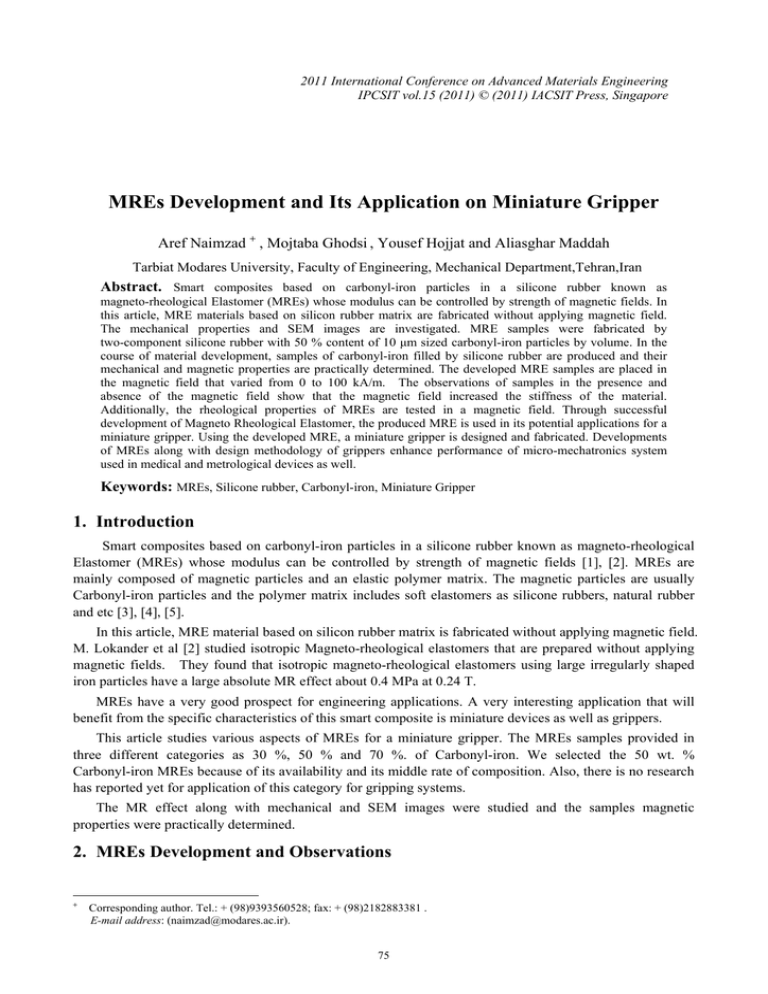
2011 International Conference on Advanced Materials Engineering IPCSIT vol.15 (2011) © (2011) IACSIT Press, Singapore MREs Development and Its Application on Miniature Gripper Aref Naimzad + , Mojtaba Ghodsi , Yousef Hojjat and Aliasghar Maddah Tarbiat Modares University, Faculty of Engineering, Mechanical Department,Tehran,Iran Abstract. Smart composites based on carbonyl-iron particles in a silicone rubber known as magneto-rheological Elastomer (MREs) whose modulus can be controlled by strength of magnetic fields. In this article, MRE materials based on silicon rubber matrix are fabricated without applying magnetic field. The mechanical properties and SEM images are investigated. MRE samples were fabricated by two-component silicone rubber with 50 % content of 10 μm sized carbonyl-iron particles by volume. In the course of material development, samples of carbonyl-iron filled by silicone rubber are produced and their mechanical and magnetic properties are practically determined. The developed MRE samples are placed in the magnetic field that varied from 0 to 100 kA/m. The observations of samples in the presence and absence of the magnetic field show that the magnetic field increased the stiffness of the material. Additionally, the rheological properties of MREs are tested in a magnetic field. Through successful development of Magneto Rheological Elastomer, the produced MRE is used in its potential applications for a miniature gripper. Using the developed MRE, a miniature gripper is designed and fabricated. Developments of MREs along with design methodology of grippers enhance performance of micro-mechatronics system used in medical and metrological devices as well. Keywords: MREs, Silicone rubber, Carbonyl-iron, Miniature Gripper 1. Introduction Smart composites based on carbonyl-iron particles in a silicone rubber known as magneto-rheological Elastomer (MREs) whose modulus can be controlled by strength of magnetic fields [1], [2]. MREs are mainly composed of magnetic particles and an elastic polymer matrix. The magnetic particles are usually Carbonyl-iron particles and the polymer matrix includes soft elastomers as silicone rubbers, natural rubber and etc [3], [4], [5]. In this article, MRE material based on silicon rubber matrix is fabricated without applying magnetic field. M. Lokander et al [2] studied isotropic Magneto-rheological elastomers that are prepared without applying magnetic fields. They found that isotropic magneto-rheological elastomers using large irregularly shaped iron particles have a large absolute MR effect about 0.4 MPa at 0.24 T. MREs have a very good prospect for engineering applications. A very interesting application that will benefit from the specific characteristics of this smart composite is miniature devices as well as grippers. This article studies various aspects of MREs for a miniature gripper. The MREs samples provided in three different categories as 30 %, 50 % and 70 %. of Carbonyl-iron. We selected the 50 wt. % Carbonyl-iron MREs because of its availability and its middle rate of composition. Also, there is no research has reported yet for application of this category for gripping systems. The MR effect along with mechanical and SEM images were studied and the samples magnetic properties were practically determined. 2. MREs Development and Observations + Corresponding author. Tel.: + (98)9393560528; fax: + (98)2182883381 . E-mail address: (naimzad@modares.ac.ir). 75 2.1. Sample Preparation The attempts have been tried to provide isotropic MREs without applying the external fields. The sample ingredients were 10 μm sized Carbonyl-iron particles, and 704 silicon rubber. Firstly, Carbonyl-iron particles were mixed with silicone rubber by using a roller about 25 min at room temperature. After all ingredients were evenly mixed, the mixture cured at room temperature without a magnetic field. Then, the pre-cured MREs were molded. MR samples with different percentages of Carbonyl-iron particles and silicone rubber were prepared. The particle weight percentage of Carbonyl-iron particles was fixed at 50% and weight percentage of silicone rubber was 50%.Fig.1 shows the prepared sample. Figure 2 shows the plastogram of provided MREs at 150oC and 50 rev/min. Note that charging MREs composite into the mixing chamber, increases the torque up to 9.06 N.m at 126 sec. This should be attributed to the homogenization of the MREs and temperature rise. The fusion process of the MREs composite is initiated and torque increases. Recall that viscosity is a direct function of torque which accounts for the torque increment. Hence, the increase in viscosity coupled with shearing generates frictional heat build-up. This is expected to increase the temperature of the MREs composite. The maximum rise in temperature for the prepared sample has been found to be 154o C. Fig. 1: MREs sample with 50 wt. % Carbonyl-iron Fig.2: Torque - time curve of the MREs for 3 min. 2.2. Microscopy The scanning electron microscopy (SEM) was used to visualize the aggregation of micron-sized iron particles. The SEM image in figure 3 shows the micro structure and spherical grains of 10 μm sized Carbonyl-iron proposed for sample. The cross sectional area of 50 wt. % MREs sample used for SEM and their micro structures are shown in figure 4. This SEM image shows the partial homogeneous situation of MREs sample. Fig. 3: SEM images of 10 μm sized Carbonyl-iron. Fig. 4: Microscopic SEM images of – 50 wt. % MRE As the prepared MREs were fabricated without any coupling agents, it seems in the SEM image that an obvious gap is available between Carbonyl-iron particles and silicon rubber. This gap will face the MREs with the adhesion challenges between iron particles and matrix. 2.3. Mechanical Test 76 Three samples with the different percentage of Carbonyl-iron were considered for measurement of normal stress and elongation percentage. The cross sectional areas of mentioned samples were selected for measurements and it noticed that by decreasing the rate of Carbonyl-iron the MREs will give the possible large value of elongation. The higher normal stress obtained from 30% MREs which is about 5.74 N/mm2 and the middle rate of stress is belonging to the sample from 50% MREs as shown in table 1. Table 1: Test results for MREs samples Sample σ max (N/mm2) L-E (%) S (mm2) MREs 30% 5.74 205.89 7.83 MREs 50% 4.35 183.93 9.80 MREs 70% 3.18 171.16 8.66 The proposed sample placed near to the magnetic field and its maximum displacement observed and recorded during the test. The test setup shown in the Fig.5 and the measurement results graphed in Fig.6. Fig. 5: Test setup for MREs sample displacement By having the size of sample as 30mm * 2.8mm* 1.2 mm, the realtionship studied between measured blocking force(Fbl) and MREs elastic modulus and the variation of elastic modulus of MREs calculated based on the formulas presented in[7] (Fig.7) Fig. 6: Tip displacement of sample vs. applied current Fig. 7: Variation of “E” vs. measured blocking force 2.4. Magnetization Test Simply, the developed MRE samples are placed in the magnetic field that varied from 0 to 100 kA/m.). It has been noticed experimentally that magnetic field increased the stiffness of the sample MREs. The magnetic flux density B (T) with applied field H(kA/m) for a 50 wt. % MREs sample observed and the B-H curve obtained from magnetization test (Fig.8). The hysteresis has low rate and the permeability and relative permeability have calculated as 6 x 10-6 and 4.7 respectively (Fig.9). 77 Fig. 8: B-H curve for 50 wt.% MREs smaple Fig. 9: µr-H curve for 50 wt.% MREs smaple 3. Application of MREs Based on the literature review, several possible applications for MRE have been considered such as variable and controllable stiffness devices, vibration absorbers, tuneable stiffness mounts and suspensions and variable impedance surfaces [8]. The most useful applications of MREs are concerning to the design and manufacturing of (1) Micro & Miniature Gripper (2) Micro diaphragm pumps (3) Micro fluid Diffuser (4) Micro Suction Cups and (5) Micro Vacuum Grippers. Using the MREs for miniature gripping is a new window for new applied research and studies. Also, this material is not conductive and it can be used with easily in medical and electrical applications. The MREs advantages for gripping application that we counts are (1) smaller usage space (2) Non-conductivity (3) No side-effect (i.e. infection) when it is using for medical applications (4) simple design and manufacturing (5)flexible (6) lower cost of manufacturing and (7) applicable in the real situation. The authors have used the setup Fig.10 to actuate the MREs jaw as for gripping the small size objects as pea and bead. This fact has found upon experimental tests with the MREs sample that the minimum required magnetic field for a miniature gripper should be 1.25 kA/m. Fig. 10: Schamatic diagram of a simple MREs minature gripper. Fig. 11: Schamatic diagram of MREs hooke-style minature gripper. An actuation coil with the current density (J) equal 4.58 A /mm2 has used for gripping experimental test .The probabilistic gripping percentage has studied in accordance to the increase in applied current and the most desired gripping point has specified. The authors have used the Hooke-style setup Fig.11 for gripping the long cylindrical objects. 4. Conclusion and Future Works In this article , we prepared MREs containing Carbonyl-iron particles based on silicone rubber without using magnetic fields and the development were considered for the miniature gripper .We presented the 78 primary steps to reach for designing the miniature gripper using 50 wt.% MREs. The starting point to design the miniature gripper obtained through deriving the permeability value from magnetization test. In future research, we intend to special customized made micro gripper for metrological and medical applications. 5. Acknowledgements The authors wish to Mr. Ehsanallah Shahi (of the Semnan University) for his cooperation related to material preparation and PARMIDA Company (chemical Corp. of Semnan) for conducting the sample mechanical tests. 6. References [1] A. Fuchs, Q. Zhang, J. Elkins, F. Gordaninejad, and C. Evernsel. Development and Characterization of Magneto-rheological Elastomers. Journal of Applied Polymer Science. 2007, 105: 2497–2508. [2] Y. Wang, Y. Hu, L. Chen, X. Gong, W. Jiang, P. Zhang, and Z. Chen. Effects of rubber/magnetic particle interactions on the performance of magneto-rheological elastomers. Journal of Polymer Testing. 2006, 25:262–267. [3] T. Shiga, A. Okada, and T. Kurauchi. Magneto-viscoelastic behavior of composite gels. Journal of Applied Polymer Science. 1995, 58: 787–792. [4] M. R. Jolly, J. D. Carlson, B. C. Munoz, and T. A. Bullions. The magneto-viscoelastic response of elastomers composites consisting of ferrous particles embedded in a polymer matrix. Journal of Intelligent Material Systems and Structures. 1996, 7: 613–622. [5] G. Bossis, C. Abbo, S. Cutillas, and S. C. Lacis Metayer. Electroactive and electro-structured elastomers. Seventh International Conference on ERF Fluids and MR Suspensions, Singapore. 2000, pp.18–27. [6] H. Jung, S. Lee, D. Jang, I. Kim, J. Koo, and F. Khan. Dynamic Characterization of Magneto-Rheological Elastomers in Shear Mode. IEEE Transactions on Magnetics.2009, 45: 3930-3933. [7] T. Nguyen, N. Goo, V. Nguyen, Y. Yoo, and S. Park. Design, fabrication, and experimental characterization of a flap valve IPMC micro pump with a flexibly supported diaphragm. Journal of Sensors and Actuators , 2008, 141: 640-648. [8] Y. Kim, J. Koo, K. Kim, and S. Kim. Vibration Isolation Strategies using Magneto-Rheological Elastomer for a Miniature Cryogenic Cooler in Space Application. IEEE/ASME International Conference on Advanced Intelligent Mechatronics, Canada, 2010, pp. 1203-1207. 79
